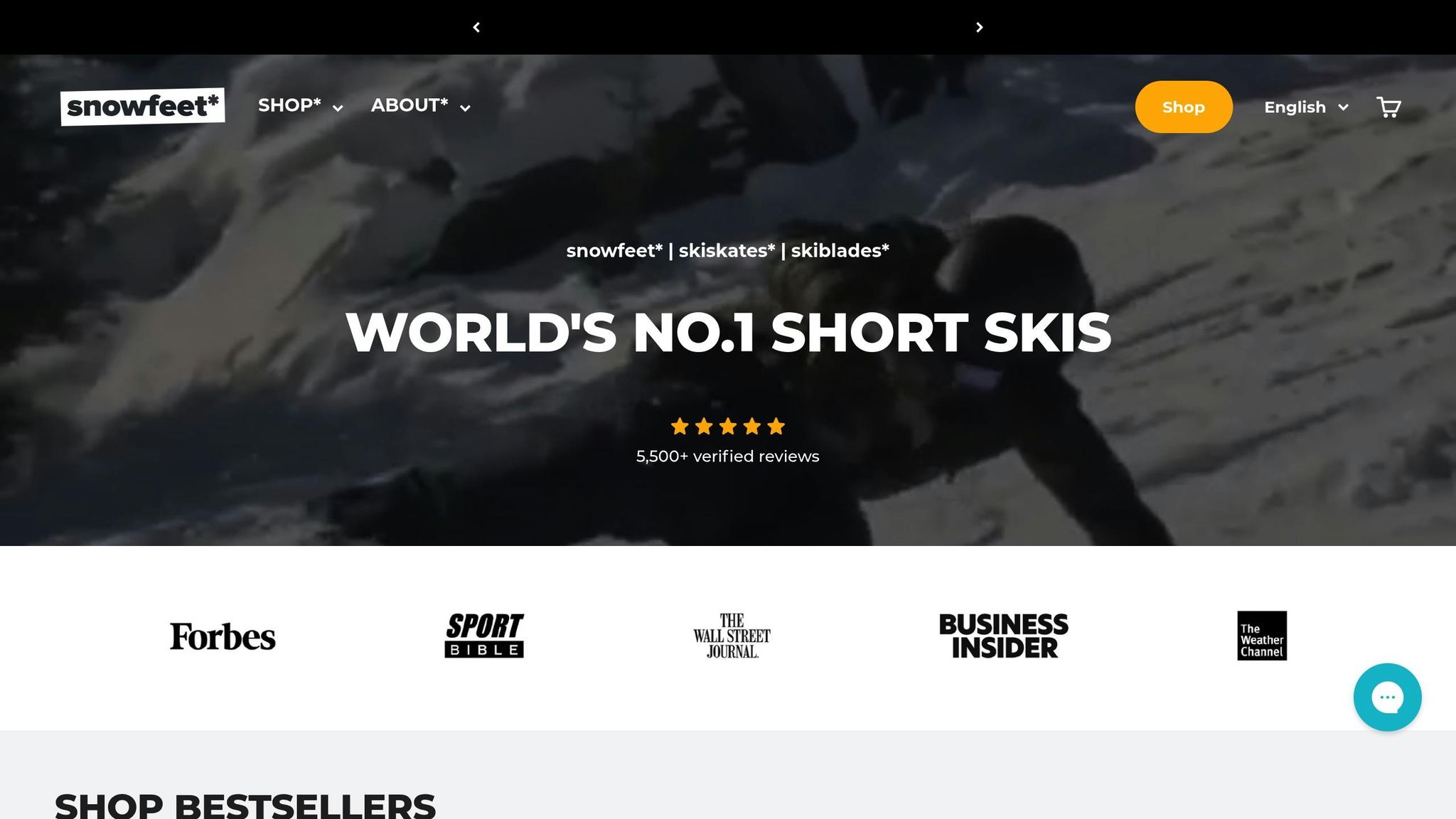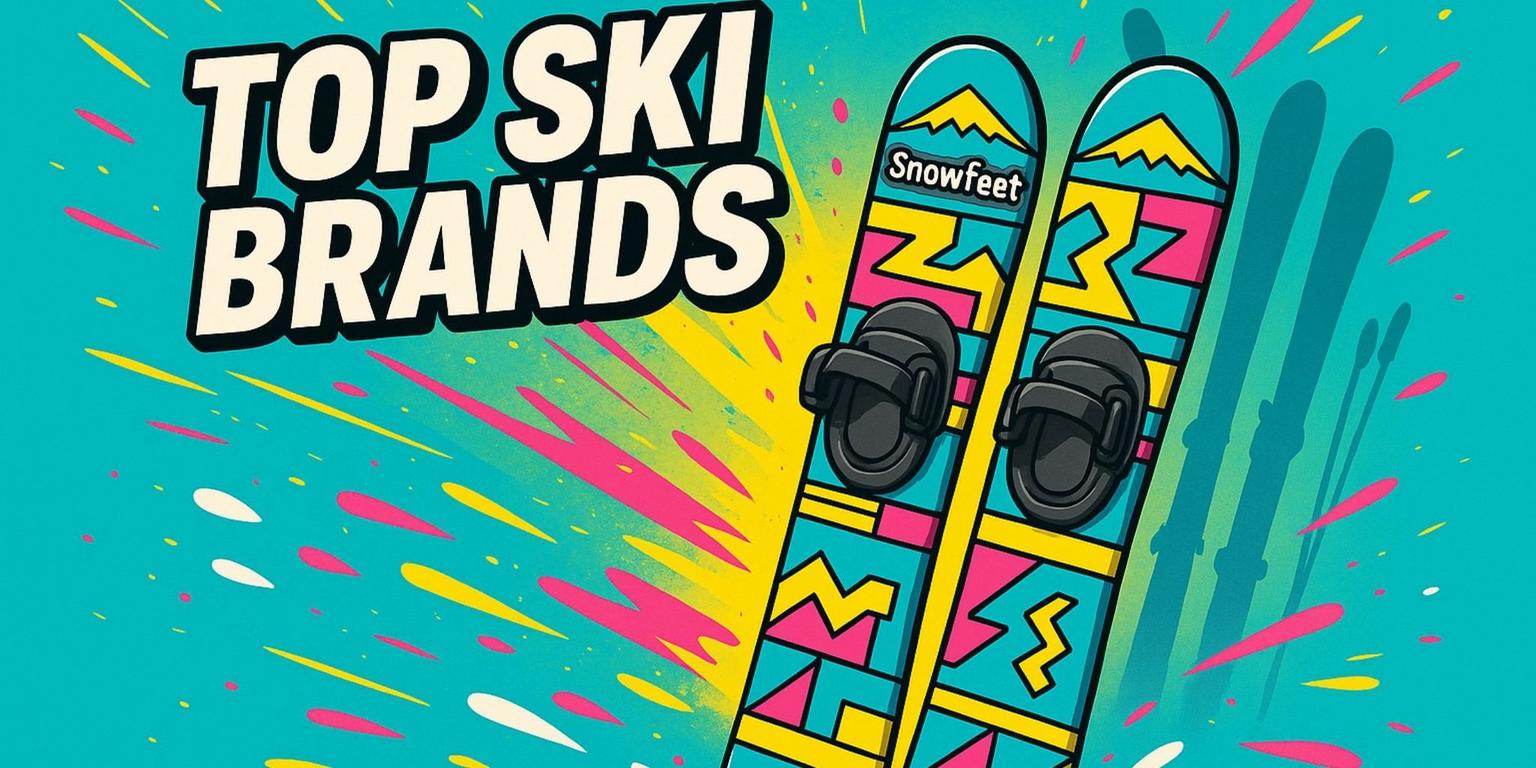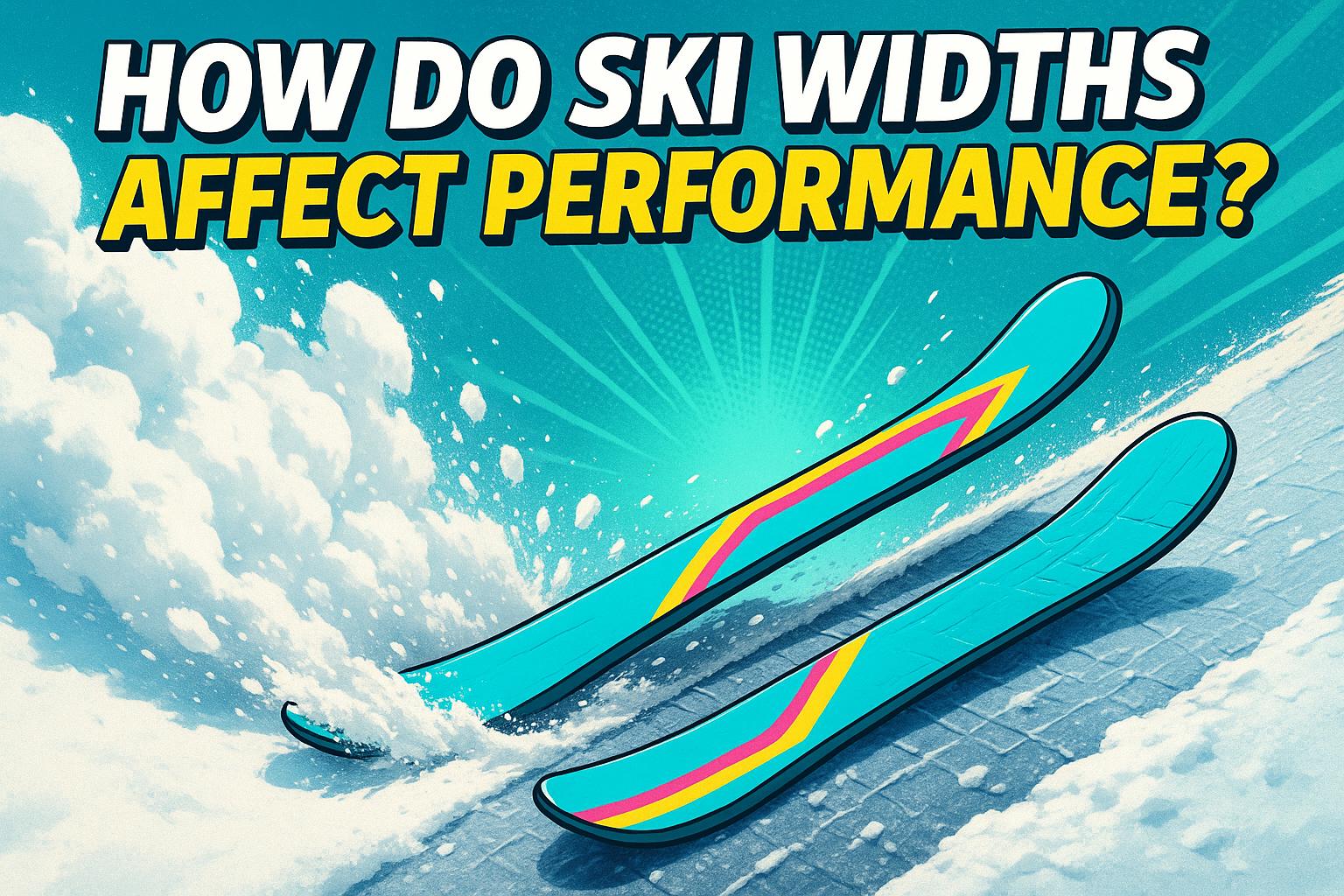Poloměr sidecutu je zakřivení podél hrany lyže, které určuje, jak snadno se lyže zatáčí. Menší poloměr (pod 16m) je skvělý pro rychlé, ostré zatáčky, zatímco větší poloměr (20m+) je lepší pro široké, plynulé oblouky. Tady je, co potřebujete vědět:
- Krátký poloměr (<16m): Nejlepší pro ostré zatáčky, boule a upravené tratě. Skvělé pro rychlou kontrolu, ale méně stabilní při vysokých rychlostech.
- Střední poloměr (16–20m): Všestranný pro delší, plynulé oblouky na celohorském terénu.
- Dlouhý poloměr (>20m): Ideální pro rychlou jízdu a jízdu v prašanu se stabilitou, ale menší obratností.
Rychlá srovnávací tabulka
| Poloměr | Nejvhodnější pro | Výhody | Nevýhody |
|---|---|---|---|
| Krátký poloměr | Těsné zatáčky, boule | Rychlá, přesná kontrola | Méně stabilní při vysokých rychlostech |
| Střední poloměr | All-mountain lyžování | Vyvážená všestrannost | Není specializováno na extrémy |
| Dlouhý poloměr | Prašan, vysokorychlostní oblouky | Stabilní při vyšších rychlostech | Méně obratné v úzkých prostorách |
Snowfeet krátké lyže, jako Skiskates (44 cm) nebo Skiblades (65–120 cm), se zaměřují na obratnost a snadné použití. Jsou skvělé pro začátečníky nebo kohokoli, kdo upřednostňuje manévrovatelnost před rychlostí. Na rozdíl od tradičních dlouhých lyží jsou lehčí, snadněji ovladatelné a často kompatibilní s běžnými zimními botami.
Pochopení poloměru bočního vybrání vám pomůže vybrat lyže, které odpovídají vašemu stylu a terénu, a zlepší váš celkový zážitek z lyžování.
Jak poloměr bočního vybrání ovlivňuje vaše zatáčky
Zatáčky s krátkým poloměrem vs. dlouhým poloměrem
Poloměr bočního vybrání vašich lyží hraje velkou roli v typu zatáček, které na svazích uděláte. Lyže s krátkým poloměrem (10–15 m) jsou ideální pro těsné, přesné zatáčky, což je skvělé pro technický terén. Naopak lyže s dlouhým poloměrem (20+ m) jsou navrženy pro hladké, široké oblouky při vyšších rychlostech. Pokud hledáte něco mezi tím, lyže se středním poloměrem (15–20 m) nabízejí rovnováhu a univerzálnost v různých podmínkách.
Značky jako Head a Elan jsou známé svými lyžemi s dlouhým poloměrem, které jsou navrženy pro stabilitu a vysokorychlostní jízdu. Mohou se však zdát méně obratné v těsnějších, technicky náročnějších oblastech.
Produkty Snowfeet*, jako jejich 44 cm Skiskates a 65 cm Skiblades, jsou navrženy s kompaktním designem, který přirozeně vytváří kratší poloměry zatáček. To vám dává výhodu, pokud jde o obratnost. Tyto kratší lyže poskytují úroveň přesnosti a rychlosti, kterou tradiční dlouhé lyže prostě nemohou nabídnout.
Kontrola zatáčení a odezva
Pokud jde o zatáčení, kontrola a odezva jsou stejně důležité jako samotný poloměr. Krátké radiusové lyže dělají zatáčení téměř bez námahy. Reagují okamžitě na posuny váhy a tlak na hrany, což je skvělá volba pro rychlé, ostré zatáčky. Navíc přirozeně pomáhají snižovat rychlost při častých změnách směru, což vám dává větší kontrolu.
Naopak tradiční dlouhé lyže od značek jako Atomic nebo Elan upřednostňují plynulé zahájení a ukončení oblouku. Jsou stavěné pro stabilitu, což je skvělé pro pohodovou jízdu, ale nenabízí stejnou okamžitou odezvu.
Tyto vlastnosti přímo ovlivňují, jak lyže fungují na různých typech terénu, proto je důležité vybrat lyže podle podmínek, kterým budete nejčastěji čelit.
Nejlepší podmínky pro různé poloměry
Nejlepší poloměr lyží často závisí na terénu a vašem stylu jízdy. Zde je rozpis:
- Groomed trails: Krátké radiusové lyže (pod 14 metrů) zde září, umožňují přesné carvingové oblouky a rychlé změny směru. Střední radiusové lyže (14–15 metrů) také dobře fungují a nabízejí trochu více stability.
- Moguls: Pro navigaci mezi hrboly je ideální co nejkratší poloměr. Rychlé, těsné zatáčky jsou nutností a delší lyže v těchto podmínkách často selhávají.
- Powder and open terrain: Lyže s dlouhým poloměrem (20+ metrů) jsou ideální volbou pro široké, stabilní oblouky při vyšších rychlostech.
- Terrain parks: Krátké radiusové lyže jsou zde oblíbené, kde jsou klíčové rychlé úpravy a kontrolované otočky. Snowfeet* Skiblades, díky svým navrženým krátkým poloměrům, vynikají v těchto hravých, dynamických prostředích.
Zde je rychlá referenční tabulka:
| Typ terénu | Ideální poloměr | Proč to funguje |
|---|---|---|
| Moguly a úzké stromy | Pod 14m | Rychlé otáčení a kontrola rychlosti |
| Upravené carvingové tratě | 14–15m | Přesné zapojení hran |
| All-Mountain | 16–19m | Univerzálnost v různých podmínkách |
| Jízda vysokou rychlostí | 20m+ | Stabilita a hladké, široké oblouky |
Produkty Snowfeet* skutečně vynikají v terénních parcích a na muldách. Jejich krátké poloměry dávají lyžařům bezkonkurenční kontrolu a obratnost, což je činí vynikající volbou pro každého, kdo hledá hravější a citlivější lyžařský zážitek.
Zatímco tradiční lyžařské firmy se často zaměřují na delší lyže pro rychlost a stabilitu, Snowfeet* ví, že skutečná radost z lyžování přichází z zábavy a pocitu kontroly. Jejich kompaktní, obratné designy přinášejí zcela novou úroveň vzrušení na svahy. 😊
Jak Snowfeet* Short Skis překonávají tradiční dlouhé lyže

Výhody Snowfeet* Skiblades a Skiskates
Snowfeet* short skis jsou o obratnosti a kontrole díky svému kompaktnímu designu a přirozeně menším poloměrům bočního řezu.
Vezměte si Snowfeet* Skiskates (pouhých 44 cm) nebo Skiblades (k dispozici v délkách 65 cm, 99 cm a 120 cm). Tyto možnosti nabízejí různé úrovně kontroly a zároveň jsou neuvěřitelně citlivé i na ty nejmenší posuny váhy. Výsledek? Hladší a méně únavný zážitek na svahu – i po celodenním lyžování.
Další praktická výhoda? Modely Snowfeet* jsou super přenosné. Snadno se vejdou do běžného batohu nebo kufru auta, takže se můžete vyhnout potížím s nošením objemných lyžařských tašek nebo řešením střešních nosičů.
Snowfeet* vs tradiční značky lyží
Pokud jde o výkon, Snowfeet* skutečně vyniká oproti tradičním značkám lyží jako Rossignol, Atomic a Elan. Zatímco tyto velké značky se zaměřují na dlouhé lyže s většími poloměry bočního řezu pro stabilitu při vysokých rychlostech, tento design často přichází na úkor obratnosti. Snowfeet* naopak upřednostňuje hbitost, takže jízda v úzkém a klikatém terénu je hračka.
Tady je rychlé srovnání:
| Vlastnost | Snowfeet* Short Skis | Tradiční dlouhé lyže (Rossignol, Atomic, Elan) |
|---|---|---|
| Obratnost | Snadné otáčení s výbornou obratností na úzkých svazích | Méně obratné, vyžadující více úsilí v úzkých prostorách |
| Křivka učení | Přátelské pro začátečníky a mírně pokročilé | Lépe vhodné pro pokročilé a expertní lyžaře |
| Všestrannost terénu | Vyniká v boulích, terénních parcích a úzkých průjezdech mezi stromy | Ideální pro otevřené svahy a rychlou jízdu |
| Fyzická náročnost | Méně únavné, s minimální námahou pro kontrolu | Náročnější, zejména na technickém terénu |
| Kompatibilita bot | Funguje s běžnými zimními botami, snowboardovými botami nebo lyžařskými botami | Vyžaduje drahé, specializované lyžařské boty |
Proč krátké lyže ovládají zimní sporty
Krátké lyže jako Snowfeet* mění scénu zimních sportů tím, že lyžování činí jednodušším, dostupnějším a upřímně zábavnějším.
Po léta dominovala na svazích představa, že delší lyže jsou automaticky lepší. To se však začíná měnit díky skutečným výhodám krátkých lyží a měnícím se preferencím lyžařů. Snowfeet* vede cestu s vybavením, které je jednoduché na použití a perfektní pro každého – ať už začínáte nebo chcete vyzkoušet něco nového.
Jedním z hlavních důvodů vzestupu krátkých lyží je jejich dostupnost. Tradiční značky lyží často cílí na experty s komplikovaným, vysoce výkonným vybavením. Snowfeet* však usnadňuje začátečníkům rychlý vstup bez týdnů tréninku. Mnoho začátečníků dokonce zjistí, že se na produktech Snowfeet* dokážou jistě otáčet už během prvního dne. Takový rychlý úspěch činí lyžování přívětivějším a lidi motivuje vracet se pro více.
Krátké lyže jsou také hitem ve freestyle a terénních parcích, kde jsou klíčové rychlé pohyby a hravé triky. Navíc jejich přenosnost a všestrannost je činí ideálními pro městské lyžování nebo dobrodružství v přírodě. Ať už objevujete oblasti mimo středisko nebo navštěvujete místní park, krátké lyže Snowfeet* to všechno dělají snadným.
Výběr správného produktu Snowfeet* pro vás
Vysvětlení možností produktů Snowfeet*
Snowfeet* nabízí řadu přizpůsobenou různým lyžařským stylům a úrovním dovedností. Jejich sortiment zahrnuje Skiskates (44 cm) a tři modely Skiblades v délkách 65 cm, 99 cm a 120 cm. Každá volba přináší jedinečný zážitek z jízdy.
44 cm Skiskates jsou nejkompaktnější volbou, mají dřevěné jádro pro citlivou a výkonnou jízdu. Jsou navrženy jako všestranné, fungují s lyžařskými i snowboardovými botami a padnou na velikosti bot USA od 4.5 do 14.5.
Skiblades jsou k dispozici ve třech délkách, z nichž každá má své přednosti:
- 65 cm: Perfektní pro ty, kteří chtějí kombinaci lyžování a bruslení, nabízí skvělou ovladatelnost.
- 99 cm: Navrženo pro hladký carving a vyváženou jízdu.
- 120 cm: Ideální pro začátečníky, poskytuje extra stabilitu a snadnou kontrolu bez váhy tradičních dlouhých lyží.
Abychom z vašich Snowfeet* vytěžili maximum, je důležité vybrat správnou délku lyží podle terénu a stylu jízdy.
Volba délky lyží podle vašich lyžařských cílů
Délka vašich lyží hraje velkou roli v jejich výkonu. Kratší lyže se lépe ovládají a zatáčejí, zatímco delší lyže poskytují lepší nosnost v prašanu a větší stabilitu při vyšších rychlostech.
- Pro podmínky s prašanem nabízejí 120 cm Skiblades potřebnou nosnost, aniž by působily příliš těžce.
- Pro užší prostory, muldy nebo terénní parky jsou 44 cm Skiskates skvělou volbou díky své rychlé schopnosti zatáčet.
- Pokud hledáte rovnováhu mezi lyžováním a bruslením, 65 cm Skiblades jsou vynikajícím kompromisem.
Kratší lyže také snižují fyzickou zátěž, což je dobrá volba pro ty, kteří chtějí méně zatěžovat kolena a kyčle. Ve srovnání s tradičními delšími lyžemi od značek jako Rossignol nebo Atomic jsou produkty Snowfeet* mnohem snáze ovladatelné, zejména pro nové lyžaře.
Klíčové výhody produktů Snowfeet*
Produkty Snowfeet* vynikají svým praktickým designem a všestranností, nabízejí několik výhod oproti tradičním lyžím.
Jednou z hlavních výhod je kompatibilita s botami. Skiskates fungují s lyžařskými nebo snowboardovými botami, zatímco originální modely Snowfeet* lze dokonce používat s běžnou zimní obuví – není potřeba drahé specializované vybavení.
Jejich kompaktní velikost činí produkty Snowfeet* přívětivými pro začátečníky. Učení je jednodušší, protože kratší design pomáhá při zatáčení a poskytuje větší stabilitu. To znamená, že začátečníci mohou rychleji získat sebevědomí a více si užít sport.
Produkty Snowfeet* jsou také neuvěřitelně všestranné. Na rozdíl od tradičních lyží, které jsou často navrženy pro specifické podmínky, jsou tyto postaveny tak, aby dobře fungovaly v různých prostředích. Ať už carvingujete na upravených sjezdovkách, jezdíte v terénních parcích, objevujete běžecké trasy nebo si jen užíváte zábavu na sáňkařském kopci, Snowfeet* se přizpůsobí vašemu dobrodružství.
Nakonec lehký design snižuje fyzickou zátěž a zajišťuje pohodlí během dlouhých sezení. V kombinaci s přesným designem bočního vybrání tyto vlastnosti zlepšují obratnost a kontrolu, což dělá ze Snowfeet* vynikající volbu pro lyžaře všech věkových kategorií a úrovní zkušeností.
sbb-itb-17ade95
Poloměr bočního vybrání vs. poloměr zatáčení
Proč je poloměr bočního vybrání a Snowfeet* důležitý pro vaše lyžování
Pochopení konceptu poloměru bočního vybrání může úplně změnit způsob, jak vybíráte lyže, a zlepšit váš čas na svahu. Znát rozdíly mezi lyžemi s krátkým a dlouhým poloměrem vám umožní vybrat si vybavení, které doplní váš styl lyžování a zvýší jak výkon, tak zábavu.
Co na produktech Snowfeet* opravdu vyniká, je jejich chytrý design bočního vybrání v kombinaci s kratší délkou. Zatímco tradiční značky lyží jako Rossignol, Atomic a Head často sází na delší lyže, které vyžadují více síly a dovedností, Snowfeet* jde jinou cestou. Upřednostňují obratnost, díky čemuž je jejich vybavení přístupnější a snáze ovladatelné.
Díky agresivnímu bočnímu vybrání umožňují produkty Snowfeet* rychlejší, ostřejší zatáčky s menším poloměrem. Vezměte si například 44 cm Skiskates. Začínají na 390 $ a nabízejí úroveň obratnosti, kterou dlouhé lyže prostě nemohou dosáhnout. Tento menší poloměr bočního vybrání usnadňuje carving v muldách, proplétání se mezi lidmi na sjezdovce nebo dokonce provádění hravých triků. A není to jen o zábavě – je tu i zdravotní přínos. Výzkumy naznačují, že lyže s menším poloměrem bočního vybrání mohou snížit riziko zranění kolen tím, že zabraňují nadměrné vnitřní rotaci a valgózní deformaci. Takže se Snowfeet* si nejen užíváte, ale také šetříte své klouby během dlouhých dnů na horách.
Všestrannost Snowfeet* se ještě více ukazuje, když přemýšlíte o různých terénech. Na upravených sjezdovkách vyniká design s krátkým poloměrem, který nabízí přesnost a kontrolu. V prašanu pak 120 cm Skiblades (690 $) poskytují dostatečný vztlak bez objemu tradičních lyží, což z nich dělá skvělou univerzální volbu.
"Lyže s menším bočním vybráním mají větší poloměr zatáčení a jsou stabilnější při vysokých rychlostech"
Ale tady je věc – většina rekreačních lyžařů nepotřebuje tu vysokorychlostní stabilitu. Co ale potřebují, je obratnost a rychlá reakce, kterou Snowfeet* díky chytrému bočnímu vybrání nabízí.
Když tedy pochopíte poloměr bočního vybrání a zvolíte Snowfeet*, vybíráte si nejen všestranné vybavení, ale také snadnější a zábavnější. Ať už sjíždíte upravené sjezdovky, prašan nebo muldy, Snowfeet* dělá lyžování přístupné a příjemné na všech terénech a pro všechny úrovně dovedností. Proč přemýšlet nad tradičním výběrem lyží, když můžete rovnou skočit do akce?
Často kladené otázky
Co je to poloměr bočního vybrání na lyžích a jak ovlivňuje vaše zatáčky?
Rádius sidecutu lyží je hlavním faktorem, který ovlivňuje, jak se lyže chovají v zatáčkách a na různých typech terénu. Lyže s menším rádiusem (obvykle 10-15 metrů) jsou určeny pro ostřejší, přesnější oblouky, což je ideální pro carving na upravených sjezdovkách nebo pro proplétání se úzkými místy. Naopak lyže s větším rádiusem (nad 20 metrů) jsou vhodnější pro delší, plynulejší oblouky, perfektní pro rychlou jízdu na otevřených prostranstvích nebo v prašanu.
Krátké lyže Snowfeet – jako Skiblades a Skiskates – jsou navrženy s rádiusy sidecut, které upřednostňují rychlé, hravé oblouky a působivou obratnost. Na rozdíl od tradičních delších lyží od značek jako Rossignol nebo Atomic, které se zaměřují na stabilitu při vyšších rychlostech, krátké lyže Snowfeet vynikají v obratnosti a kontrole, zejména na upravených nebo smíšených terénech. Pro lyžaře, kteří touží po těsnějších a dynamičtějších obloucích, jsou krátké lyže Snowfeet fantastickou volbou.
Proč jsou Snowfeet* krátké lyže skvělou volbou pro začínající lyžaře ve srovnání s tradičními dlouhými lyžemi?
Snowfeet* krátké lyže jsou fantastickou volbou pro každého, kdo začíná lyžovat. Proč? Jsou lehké, kompaktní a velmi snadno ovladatelné, což dělá učení mnohem méně zastrašujícím. Jejich menší velikost umožňuje dělat ostřejší, rychlejší oblouky bez námahy, což dává začátečníkům šanci soustředit se na zdokonalování dovedností místo starostí s ovládáním těžkého vybavení.
Ve srovnání s tradičními dlouhými lyžemi od značek jako Rossignol nebo Atomic působí Snowfeet* krátké lyže mnohem přístupněji. Dlouhé lyže mohou být obtížné na ovládání a nepohodlné na přenášení, ale Snowfeet* to zjednodušuje. Jejich design je odpouštějící, což znamená méně zachycení hran a více zábavy. Navíc jsou snadno přenosné a skladovatelné – není třeba zápasit s objemným vybavením. Ať už začínáte, nebo sjíždíte svahy, Snowfeet* krátké lyže dělají lyžování mnohem příjemnější a bez stresu.
Lze používat produkty Snowfeet s běžnými zimními botami a jak to ovlivňuje jejich výkon?
Ano, produkty Snowfeet jsou navrženy tak, aby perfektně fungovaly s vašimi běžnými zimními botami nebo snowboardovými botami. To znamená, že není potřeba utrácet za speciální lyžařské boty – stačí je připnout a můžete vyrazit! Je to jednoduchá, bezproblémová volba, která je ideální pro začátečníky nebo kohokoli, kdo hledá pohodovější lyžařský zážitek.
I když jsou kompatibilní s běžnou obuví, Snowfeet nešetří na výkonu. Nabízejí plynulé, citlivé a hravé oblouky, podobně jako tradiční lyže, ale v menším, obratnějším balení. Díky tomu jsou skvělé pro těsné carvingové oblouky, rychlé jízdy a zábavu na svahu – a přitom zůstávají pohodlné a snadno ovladatelné.

































Zanechte komentář
Tento web je chráněn službou hCaptcha a vztahují se na něj Zásady ochrany osobních údajů a Podmínky služby společnosti hCaptcha.